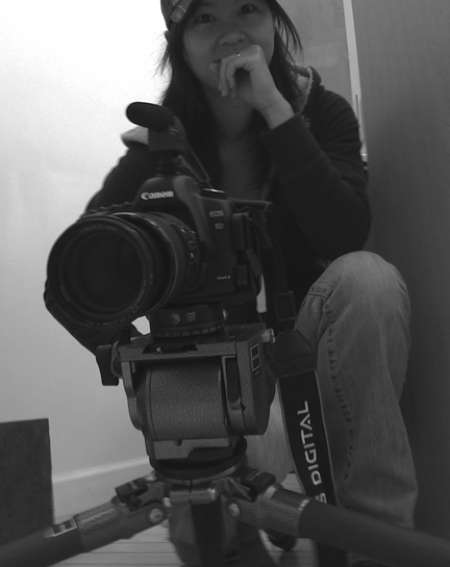Julienne Hsu
Website: www.juliennehsu.com
Painter: Los Angeles
It was a day where every line was perfect. I woke to a postcard horizon – blue sky resting on the dark Pacific. On the road every bus, every car fit into every lane just right. It continued as I met Julienne Hsu. Inside her studio, a dog named Tofu with impossibly long legs floated to a stance and loped straight into my ribs with a greeting. And beautifully smooth concrete walls stretched far up to the sky.
It was impressive how those walls shut out the heat and bustle of Los Angeles. But even if they were less efficient, I don’t think Julienne would have noticed.
“Taiwan is kind of like LA. So I was used to this. It was pretty fast—always a lot of cars, a lot of trash, stray dogs, a lot of people on scooters. I remember when I was little I didn’t really pay much attention to the cityscapes. My dad would take me a little bit outside of the city where there are more hiking trails. We would go there pretty often.”
“We could go all the way up to the mountain top and there would be monkeys. And you’d have vendors selling treats for the monkeys. But they said the monkeys got wild—they don’t want to take it anymore. They knew you had the food so they started attacking people. They would just grab your bag. So they barred that section. You can’t really go in there anymore.”
She mentioned how it’s a tiresome story: human beings exploiting nature to the point where nature is exhausted and sort of rejects us, one way or another. Of course it doesn’t happen that way all the time.
Like most of us, Julienne has good memories of the natural world, too. And once a teenager, recently moved from Taiwan to Los Angeles, she’d really begin to see the differences between those mountains and the city.
“The way I think about nature is that it’s not that natural. At least in our world. Like the trees on the sidewalk, they’re confined in that space. In my work I would try to show them in their confined space without making the viewer have to pity them, or to have to sympathize with them. So those trees in the sidewalk, they’re in their own space but they’re completely happy in their own space.”
 Display Display |
I like Julienne’s textures, too. Heavy patches of paint are swathed and even sometimes harshly scraped across those huge canvases: six feet wide. Four feet high. Or even larger.
“I definitely like to overwhelm the viewer. To feel like you can almost walk into it.”
More than with the objects themselves, and perhaps more than with words, Julienne speaks with the empty spaces in her work. They captivate you. Just asking you to fill in the blanks. Soothing you with color. Persuading you to daydream just a little. To complete the story however you want. And every so often, there’s a perfect line. Just enough.
“I tend to organize the space. Often I will look really hard to try to get a line in a drawing right, and once I feel like I have the line right it doesn’t matter what I do within that space. It’ll all make sense because the line will tell a lot of the story.”
So it’s about trusting us, as the viewer – trusting that we can understand. An artist like Julienne can give us just one or two things to look at, and then we’ll finish it. That’s a beautiful connection, and a connection that’s not at all out of reach.
“I always feel like it’s unfortunate to have a huge gap between the general public and the art they see, and I don’t know why people want to deny that or not do something about that. Just look, and then feel what you’re feeling. That’s more than enough.”
Julienne is onto something. I like how she wants to bridge that gap. And lately her work is focused on an exceedingly relatable subject. She’s been painting dogs.
“I feel like I’m almost being manipulative [laughs]. ‘I know people like dogs…so let’s paint some dogs!’ But it just started out because I love my dog and I wanted to paint her. It makes people smile.”
And that’s it. They’re not poker-playing dogs. They’re not cartoon-ish dogs. They’re just dogs. Beautiful. Natural. Exploring their dog parks. Wandering in open space. Perhaps even ignoring their owners. There’s a deep emotion she’s reaching for – a wrestling with the notion of owning a pet.
“It’s kind of like going to a zoo and looking at a tiger and you feel like, ‘oh wow, there’s a tiger!’ But then the tiger is in a cage. So in a way, it’s a very guilty pleasure to have a dog. You want it to have a little bit of nature to use, but you have to leash it all the time, you have to train it right, you have a responsibility toward it.”
 |
“The way I see it is that she wants to go out, but sometimes what’s out there is dangerous for her. So it’s kind of a strange feeling for us to want them to be free but not free at the same time.”
There’s something very appealing about the way Julienne thinks. And I love the way she’s been presenting her work. This project on dog parks is bright, and her projects, her colors, her explorations – they’ll keep getting brighter.
And I’ll keep going back for those perfect lines.
{september 2009}
(images c/o Julienne Hsu)/font>
All stories are copyright of Gregory Koutrouby and A Thousand Stories unless otherwise noted.
